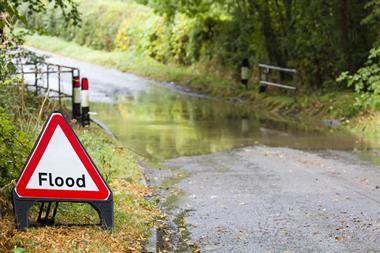Despite the prominence of the Covid-19 pandemic, Jonathan Guard, commercial insurance director at LexisNexis Risk Solutions, tells Insurance Times that flood risks should not be ignored and that better using perils data can benefit brokers. Savan Shah gets the details
February was the wettest month on record, we had storms Ciara and Dennis too. Do you think Covid-19 has taken the focus off the challenge the sector is facing in managing environmental risks?
The storms at the start of the year may seem like a distant memory, but they resulted in claims payments exceeding £363m. We then had the driest spring on record leading to the government’s Drought Group convening on the 13 July. It does seem like we need to get used to a climate that veers from deluge to drought and back again, and all the risk that creates.
In a ‘normal’ world there would still be much public debate about Ciara and Dennis and what can be done to mitigate losses in the future. While Covid-19 has diverted attention, behind the scenes we know that there remains a significant focus on developing strategies to tackle the increasing risks of extreme weather to better protect people, properties and possessions from harm.
The hunger for data to understand perils risk is as high as ever and the way in which that data is being applied demonstrates how significant a factor it has become in managing home and commercial property insurance business. Historical flood events, windstorms and subsidence are now part of pricing models for many providers across the market.
Perils risk scores are now streamlined for use alongside publicly available data, identity verification data and property and business data for automated e-trading. Perils risks can be visualised at individual property level, at point of quote, or across an entire book of business to calculate exposure in real-time, plan resourcing, identify market opportunities and spot areas of accumulations.
How an extreme weather event would be handled in a Covid-19 world is a question that has yet to be answered, but it will undoubtedly be front of mind for the industry’s claims professionals as we approach the autumn months.
How has the industry developed its understanding of environmental risks compared to five years ago? Has there been much change?
Predicting the weather is notoriously difficult – the key for the insurance market is to know with some certainty that a significant event has either occurred, impacting the risk of the property, or is approaching. Where once the industry relied on static data updated once or twice a year, the market can now access live data on floods, river flows and windstorms. This dynamic data is a real step in the right direction in how the market can prepare and respond to weather events.
Managing extreme events is a highly pressurised time for insurance providers – using dynamic data allows them to make immediate adjustments to their pricing and underwriting in the affected areas where risks are changing, creating areas for exposure and underinsurance if not addressed.

Perils data is also now specific to the individual property – the footprint and geometry - factoring for both the elevation and distance from the nearest water course. The ease of access to geospatial data through insurance specific mapping products as well as the delivery of perils data directly into quoting systems is creating a comprehensive understanding of individual property risk, speeding up quotes, improving pricing accuracy and reducing manual processes.
How do you think brokers could better utilise perils data?
Regional brokers are often on the front line when an extreme weather event occurs. The latest geospatial mapping technology allows brokers to upload their policy data to quickly identify policyholders at risk before, during and after an extreme weather event. The data also allows them to take immediate action on new business based on what’s happening in real-time.
With regard to quoting activity, brokers need to know they are passing on the right risks to their insurer partners – utilising perils risk scores at point of quote for e-trading not only speeds up the quote process but it provides verified risk information to the insurer on the property being underwritten.
Visualisation of perils data using mapping tools also has a valuable role to play in helping brokers refine their regional targeting and marketing activities. In fact, we have seen insurance providers expand their addressable market by 8% through the insights they have gained through data visualisation.
Flood Re has an end date, albeit that is still some way off. What steps do you think could help build greater resilience against flood risks, today and in the near future?
I think there could be more onus on homeowners to take action to protect their homes if they are known to be in a flood risk area. Along with greater investment in making new properties flood resilient, I would also hope to see much greater use of flood resilience measures, such as sensors on walls, the use of flood doors and electrical points moved up walls in existing properties known to be at risk of flood.
What do you think are the biggest lessons learned from the storms at the start of the year?
We all saw what happened with the hastily erected flood dams – in some cases they simply exacerbated problems because once the water had breached the dam it had nowhere to escape to. Flood defences, some over 100 years old, also failed.
We therefore welcome serious ongoing investment in building flood resilience in major cities, including a recent commitment by the UK government to invest £170m in additional flood defences so that homes and businesses across the country will be better protected and more resilient in future. This includes £5.2bn to create around 2,000 new flood and coastal defences by 2027, as well as support to help households and businesses get back on their feet more quickly after flooding.
The plans also include £200m for innovative projects, such as sustainable drainage systems and nature-based solutions like temporary or permanent water storage areas.
The proposed changes to the Flood Re scheme make perfect sense. Flood Re would offer discounted premiums to households that have fitted flood resilience measures to their property and permit the payment of claims to include an additional amount to ‘Build Back Better’ homes after flooding.
The insurance sector also needs to consider if it makes sense to continue restoring properties to the same standard they were before an event.

Hosted by comedian and actor Tom Allen, 34 Gold, 23 Silver and 22 Bronze awards were handed out across an amazing 34 categories recognising brilliance and innovation right across the breadth of UK general insurance.





















































No comments yet